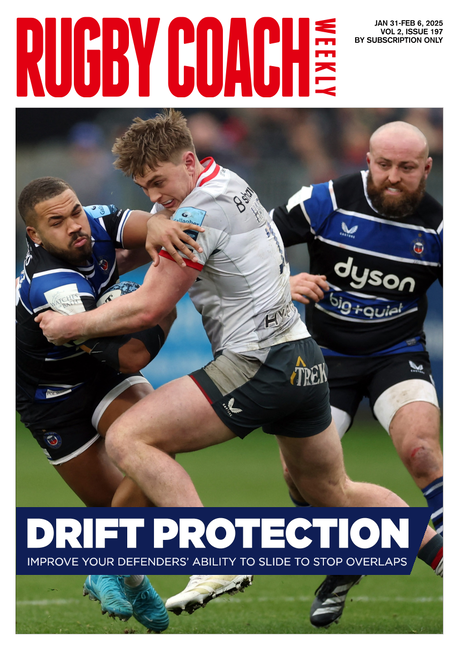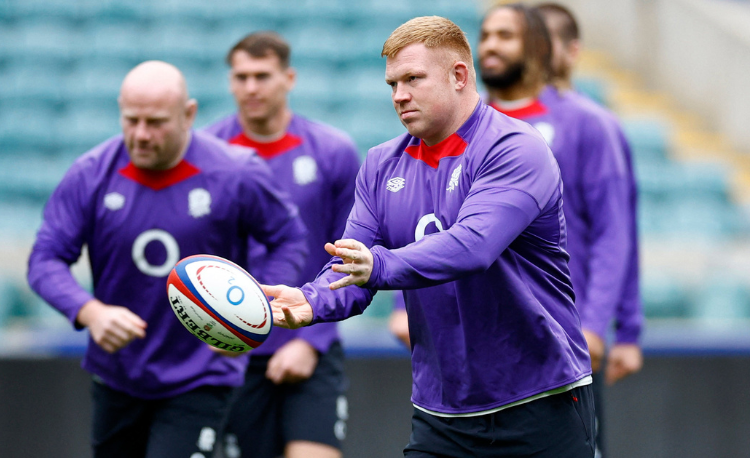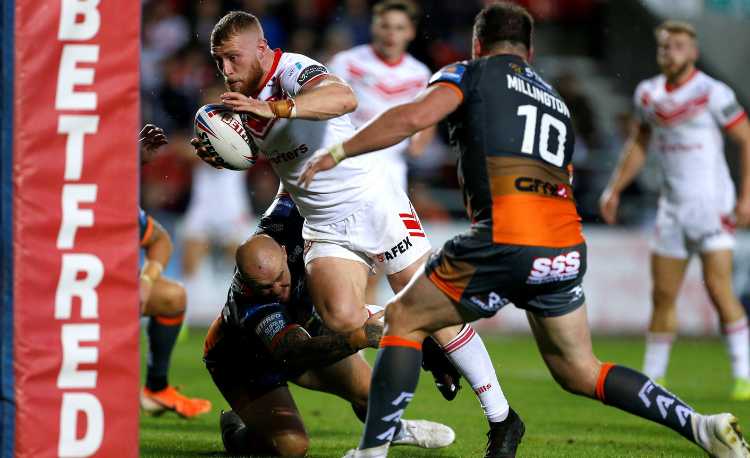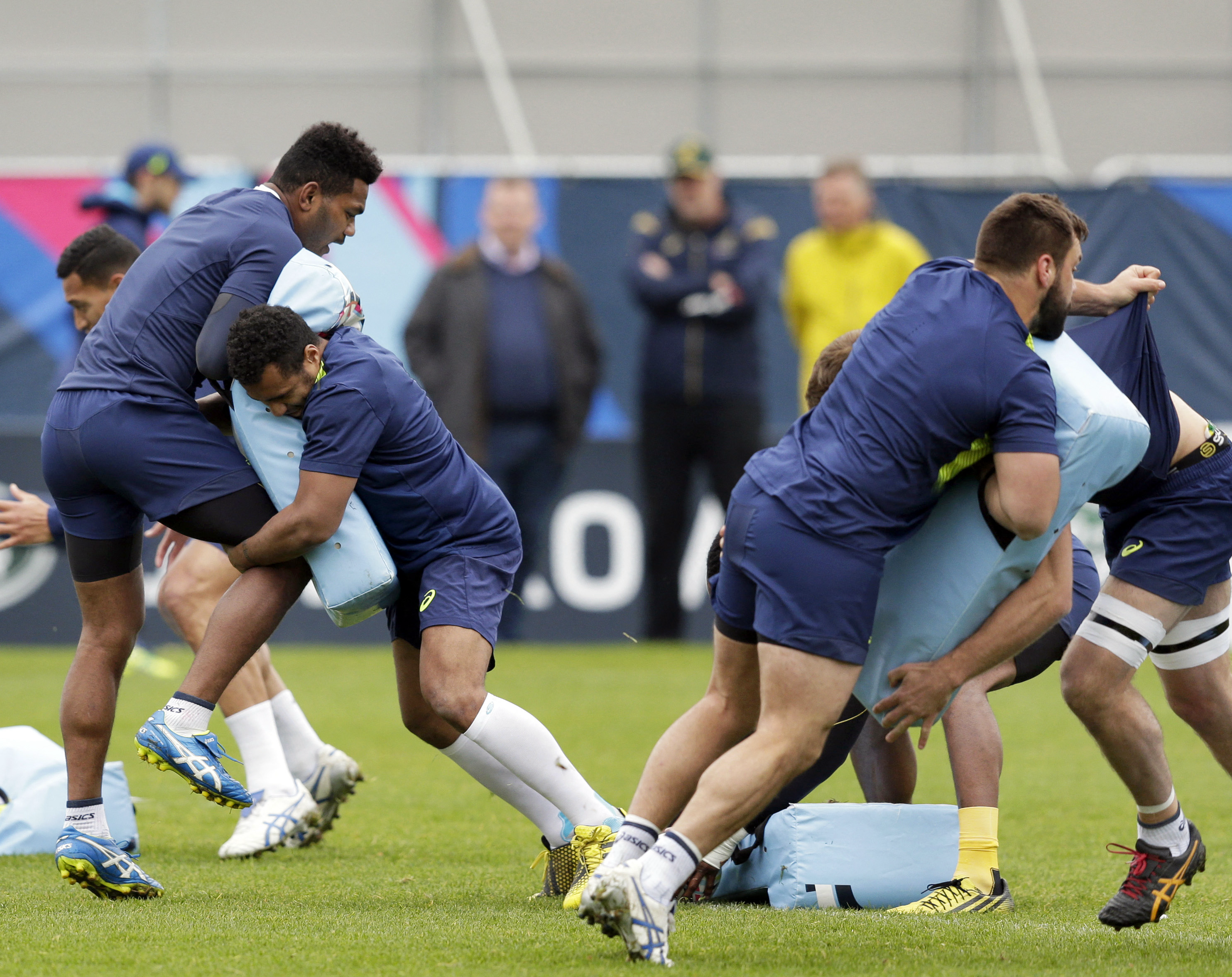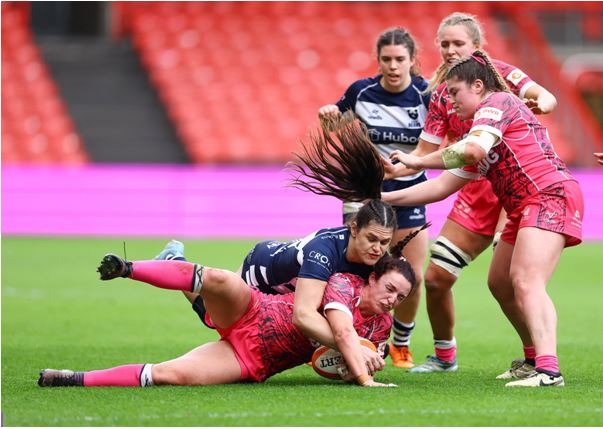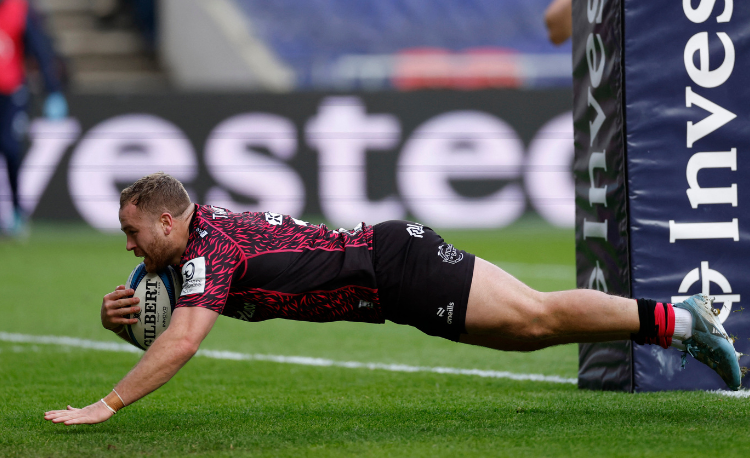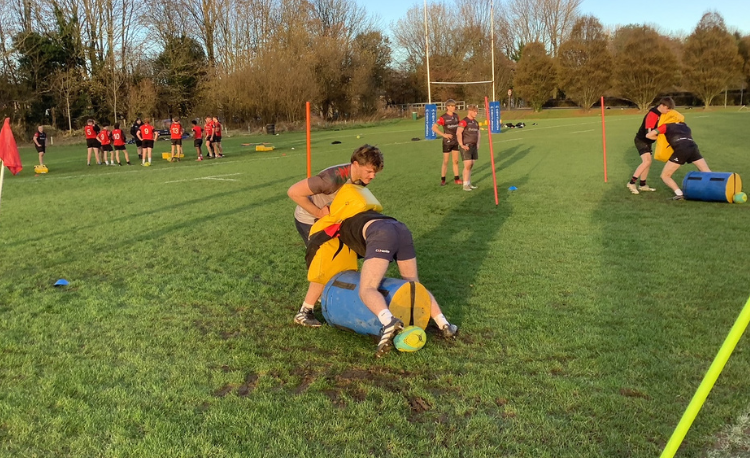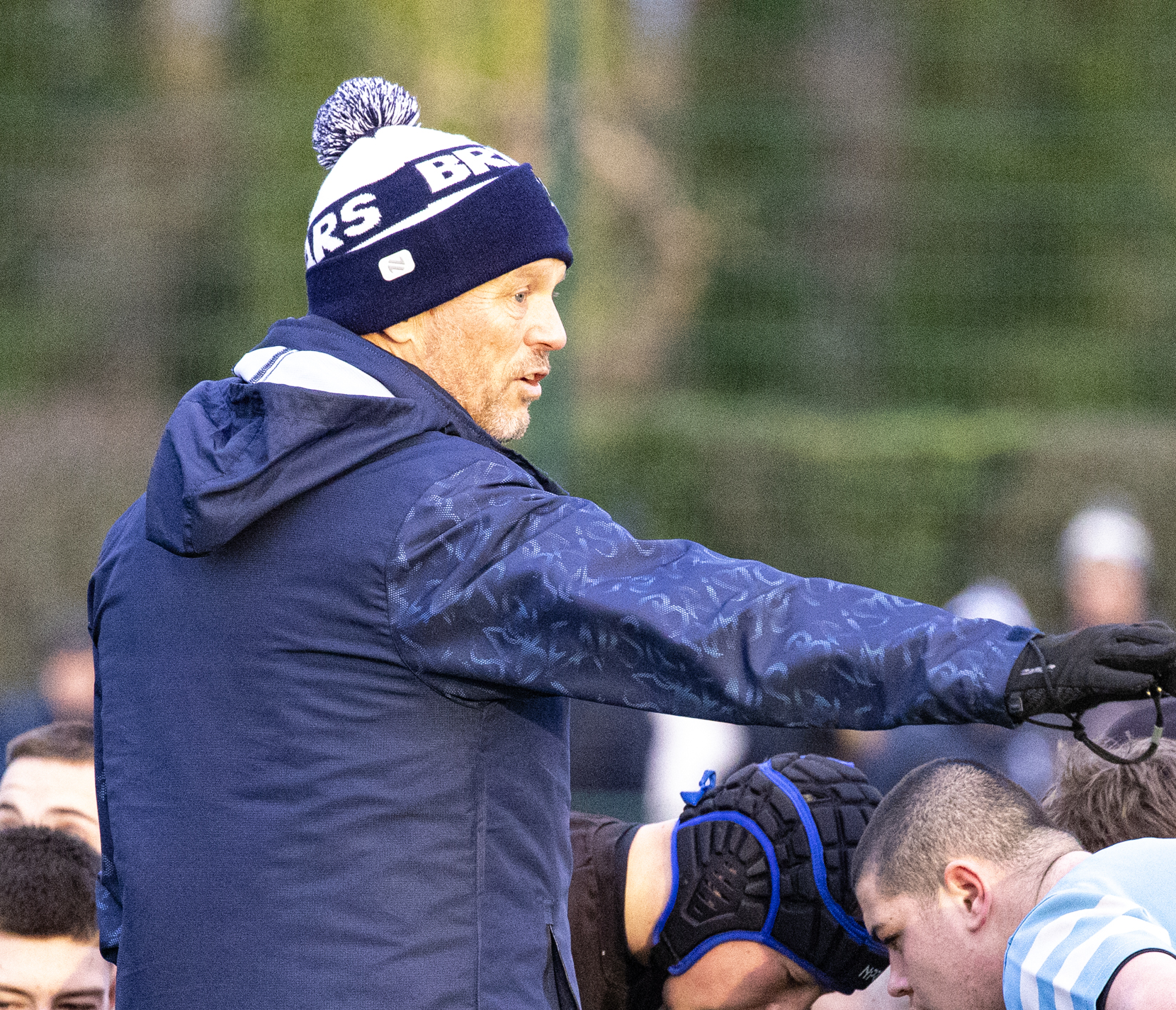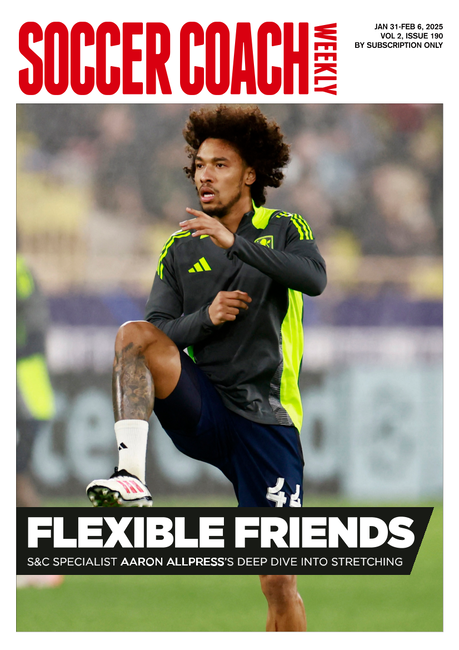Sharpening the right skills that matter
Every team wants to improve their skills, especially before a new season. Concentrate your efforts on focusing on what you need to work on to achieve your goals for the season.

PIECES OF THE PUZZLE
I am a great fan of Stephen Covey, who wrote The Seven Habits of Highly Effective People. He said that we should “begin with the end in mind”.
We should know what we want to play like. This is made up of a large number of pieces of an interlocking puzzle. We need to work on those pieces.
In the pre season period, look at what parts of the puzzle you can develop early in the training cycle.
You could be working on lifting pods in the lineout, or the hooker’s throw, before you look at the full lineout nearer the playing part of the season.
In your touch games, you can be putting into place continuity plays off the 9. For instance, you could stipulate that the fi st pass from the “ruck” must be behind the first runner who acts as a decoy runner.
You could call this a name in the touch game which helps ingrain the thought in the players. Therefore, though you are not at full pace, or using full contact games yet, you are introducing parts of the game plan as soon as you can.
When you are ready for the full team run, or unit training, you have a head start in certain areas.
Ideally, use lots of games in pre-season training. They can be part of your fitness regime and in part to work on aspects of the game you are concentrating on.
For instance, you could run a touch rugby game which works hard for five minutes, then has a two and half minute rest. The players then do not just treat the game as a break and know they have to focus hard for that short period of time.
The recovery times in between games start to match the sort of work and recovery times balances we might have in a match. The fitness and conditioning staff can adjust these as you get closer to our competitive phase.
The version of touch rugby you play should change all the time, depending on what you are concentrating on. Generally, it is best to always use two-handed touch, but adjust other conditions to highlight a particular aspect of the game.
Here are some examples:
Ball placement: the ball carrier has to use a particular type of ball placement when he is touched. It could be jack knife type placement or a squeezeball.
Patterning: the team with the ball have to use certain plays that match part of our game plan.
Defenders in certain parts of the field: the defence is conditioned to react as it would in particular areas of the field, like using a push defence in our 22m area.
Ideally, always have a referee on the pitch. The referee makes sure that the defence is always onside. Do not play more than eight to 10 aside so there is little chance for rest and the players have plenty of touches on the ball.
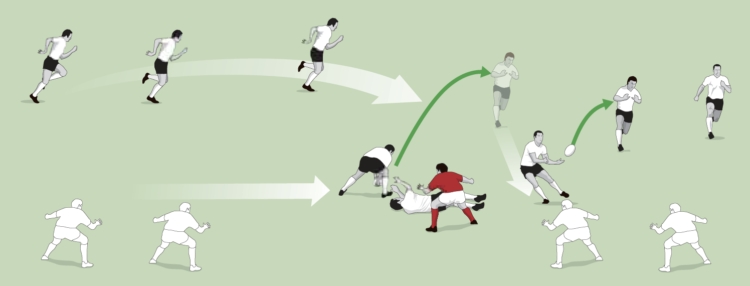
Develop your patterns of play using touch rugby. In this example, the attack tries to get two passes in before contact. The clearing passer then moves the ball the same way, with two more passes.
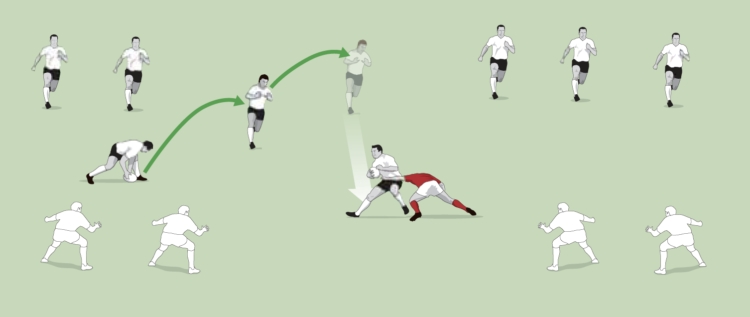
The aim of this pattern is to exhaust the defence, which is constantly having to chase over to cover the attacks.
Add in other specific elements such as ball placement or short plays. Short plays could include pops and runs coming from the clearing passer. It should help the timing of the plays as well as ingrain good habits.
Cheating in touch rugby is frustrating because it undermines what we are trying to achieve. You canl “sin bin” players for frequent offences, sometimes sending them to the conditioner for extra work.
Deal with mistakes in a similar way. A forced error will lead to a turnover of the ball. An unforced error which you are keen to eradicate might lead to some more time with the conditioner.
Create a culture of ownership where the players are responsible for their errors. The time with the conditioner might be fitness based in the fitness section of your pre season training or it might be specific to the mistake. For instance, a poor pass in the game might mean ten passes with the conditioner before being allowed to return to the game.
Rugby is a game of concentration and refocusing. When the ball is in play, players need to be focused and concentrating on their tasks and roles. When the ball is out of play, then they are refocusing. Use training games to replicate those situations.
Short bursts of game activity, say for three minutes, with a 30 second down time can match passages of play in a match. The time when the players are not running around, they can catch their breath, discuss tactics, motivate each other and then switch back on to the game.

Another theme you can draw out using games is working in threes in defence. The middle player of the three pulls and pushes the other two players. It works on communication and trust.
Especially at the start of a season's campaign you might have new players, for example, this season we have ten new players in the squad. They need to get to know the moves and plays. Games can help redefine the players' trust in each other.
Use a touch game of five or six attackers versus three defenders (plus two or three other defenders on sideline that can rotate in). It would be in a box 30m long by 30m wide , but you can alter the width to change the demands on the defence.
The attackers have six balls on their start line and attempt to score all six tries before the game time elapses (three or four minute games). Any attacking error made and the attacking side must restart with the same ball on their start line. Once the time finishes or the attackers score six tries, the other side attempts to beat their score.

PIECES OF THE PUZZLE
I am a great fan of Stephen Covey, who wrote The Seven Habits of Highly Effective People. He said that we should “begin with the end in mind”.
We should know what we want to play like. This is made up of a large number of pieces of an interlocking puzzle. We need to work on those pieces.
In the pre season period, look at what parts of the puzzle you can develop early in the training cycle.
You could be working on lifting pods in the lineout, or the hooker’s throw, before you look at the full lineout nearer the playing part of the season.
In your touch games, you can be putting into place continuity plays off the 9. For instance, you could stipulate that the fi st pass from the “ruck” must be behind the first runner who acts as a decoy runner.
You could call this a name in the touch game which helps ingrain the thought in the players. Therefore, though you are not at full pace, or using full contact games yet, you are introducing parts of the game plan as soon as you can.
When you are ready for the full team run, or unit training, you have a head start in certain areas.
GAMES TO MIMIC MATCHES
Ideally, use lots of games in pre-season training. They can be part of your fitness regime and in part to work on aspects of the game you are concentrating on.
For instance, you could run a touch rugby game which works hard for five minutes, then has a two and half minute rest. The players then do not just treat the game as a break and know they have to focus hard for that short period of time.
The recovery times in between games start to match the sort of work and recovery times balances we might have in a match. The fitness and conditioning staff can adjust these as you get closer to our competitive phase.
The version of touch rugby you play should change all the time, depending on what you are concentrating on. Generally, it is best to always use two-handed touch, but adjust other conditions to highlight a particular aspect of the game.
Here are some examples:
Ball placement: the ball carrier has to use a particular type of ball placement when he is touched. It could be jack knife type placement or a squeezeball.
Patterning: the team with the ball have to use certain plays that match part of our game plan.
Defenders in certain parts of the field: the defence is conditioned to react as it would in particular areas of the field, like using a push defence in our 22m area.
Ideally, always have a referee on the pitch. The referee makes sure that the defence is always onside. Do not play more than eight to 10 aside so there is little chance for rest and the players have plenty of touches on the ball.
EXAMPLE OF PATTERNING

Develop your patterns of play using touch rugby. In this example, the attack tries to get two passes in before contact. The clearing passer then moves the ball the same way, with two more passes.

The aim of this pattern is to exhaust the defence, which is constantly having to chase over to cover the attacks.
Add in other specific elements such as ball placement or short plays. Short plays could include pops and runs coming from the clearing passer. It should help the timing of the plays as well as ingrain good habits.
CHEATING AND MISTAKES IN TOUCH RUGBY
Cheating in touch rugby is frustrating because it undermines what we are trying to achieve. You canl “sin bin” players for frequent offences, sometimes sending them to the conditioner for extra work.
Deal with mistakes in a similar way. A forced error will lead to a turnover of the ball. An unforced error which you are keen to eradicate might lead to some more time with the conditioner.
Create a culture of ownership where the players are responsible for their errors. The time with the conditioner might be fitness based in the fitness section of your pre season training or it might be specific to the mistake. For instance, a poor pass in the game might mean ten passes with the conditioner before being allowed to return to the game.
SMARTER CONCENTRATION
Rugby is a game of concentration and refocusing. When the ball is in play, players need to be focused and concentrating on their tasks and roles. When the ball is out of play, then they are refocusing. Use training games to replicate those situations.
Short bursts of game activity, say for three minutes, with a 30 second down time can match passages of play in a match. The time when the players are not running around, they can catch their breath, discuss tactics, motivate each other and then switch back on to the game.
DEFENCE WORKING IN THREES

Another theme you can draw out using games is working in threes in defence. The middle player of the three pulls and pushes the other two players. It works on communication and trust.
Especially at the start of a season's campaign you might have new players, for example, this season we have ten new players in the squad. They need to get to know the moves and plays. Games can help redefine the players' trust in each other.
Use a touch game of five or six attackers versus three defenders (plus two or three other defenders on sideline that can rotate in). It would be in a box 30m long by 30m wide , but you can alter the width to change the demands on the defence.
The attackers have six balls on their start line and attempt to score all six tries before the game time elapses (three or four minute games). Any attacking error made and the attacking side must restart with the same ball on their start line. Once the time finishes or the attackers score six tries, the other side attempts to beat their score.
Newsletter Sign Up
Coaches Testimonials

Gerald Kearney, Downtown Las Vegas Soccer Club

Paul Butler, Florida, USA

Rick Shields, Springboro, USA

Tony Green, Pierrefonds Titans, Quebec, Canada
Subscribe Today
Be a more effective, more successful rugby coach
In a recent survey 89% of subscribers said Rugby Coach Weekly makes them more confident, 91% said Rugby Coach Weekly makes them a more effective coach and 93% said Rugby Coach Weekly makes them more inspired.
Get Weekly Inspiration
All the latest techniques and approaches
Rugby Coach Weekly offers proven and easy to use rugby drills, coaching sessions, practice plans, small-sided games, warm-ups, training tips and advice.
We've been at the cutting edge of rugby coaching since we launched in 2005, creating resources for the grassroots youth coach, following best practice from around the world and insights from the professional game.

